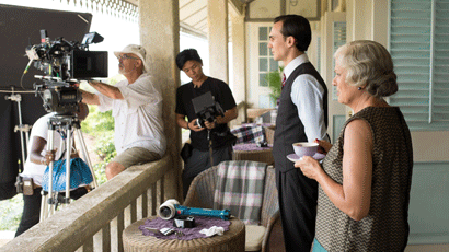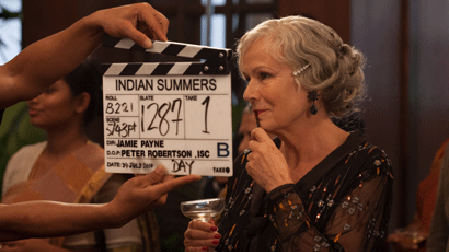Exploring 1930s India in PBS' 'India Summers'

At the heart of Simla’s society is Cynthia (Julie Walters), widowed doyenne of the Royal Club. Ralph Whelan (Henry Lloyd-Hughes) is private secretary to the Viceroy of India.
BOSTON—The hot and humid summer days and nights of Malaysia substituted for the infamously similar climes of India—its neighbor across the Sea of Bengal—for the series “Indian Summers,” which just wrapped production on its second of two seasons. The nine-episode first season is currently airing on PBS’ “Masterpiece” through Nov. 22), presented by WGBH Boston.
The first season of the lavishly produced drama has already aired in the United Kingdom, receiving near-universal praise for its epic scope, casting and cinematography. “Indian Summers” is a co-production of New Pictures for Channel 4 and “Masterpiece” in association with All3Media International.
Like the enormously successful “Downton Abbey”—nearing its conclusion this winter on “Masterpiece” —“Indian Summers” chronicles the myriad societal shifts of British wealth and culture underway nearly a century ago. In 1932, with much of the world teetering on the edge of political upheaval, the height of privilege was said to be a Brit living in India, and the high point was the summer season at the hard-partying colonial retreat of Simla in the Himalayan foothills
Julie Walters stars as the glamorous doyenne of an English social club in the twilight era of British rule in India. Set in a subtropical paradise, “Indian Summers” explores the collision of the high-living English ruling class with the local people agitating for Indian independence. As the drama unfolds, the two sides alternately clash and merge in an intricate game of power and politics.
Irish director of photography Peter Robertson (“Peaky Blinders”) had been called to Malaysia on short notice to shoot most of the remaining season one segments after the pilot episode had already been completed. Thus, some of the key technical decisions for the first season had already been made before his arrival.

“We shot the series largely on Penang Hill in Malaysia about 500 kilometers from [the capital city of] Kuala Lumpur because there were four or five really good, really old colonial buildings on the hill and in the town itself, and some other colonial-type structures in the city center that were very much of the era when the story takes place,” Robertson said. And apart from one major courtroom scene in a converted old colonial building, the DP said everything was shot on location.
“To be honest, I didn’t get to choose the cameras and some of the other equipment we wound up using. If it had been up to me, I probably would have gone with Arri Alexa for A-camera, but as it turned out, we were shooting Red [Epic] Dragon. I was surprised about that. I had shot a lot of Red Dragon in previous years in Ireland, but everything in the past two or three years has been Alexa because that’s just where the world has gone,” Robertson said.
“The Red camera performed really well. I thought it handled the highlights and the huge contrast range between day exterior and interior scenes very well. They were very keen to bring the outside world into the interior, if that makes any sense. For example, there were these large doors on the veranda that they wanted to keep open so that with the interiors you could see as much of the forest and landscape as possible,” he said. “So our cameras were massively challenged.”
Robertson agreed to continue using Zeiss Ultra Prime lenses (another decision made prior to his arrival) because he opted to switch from a Moviecam system to Steadicam.
“I thought Steadicam was much more in tune with the time, the era, where the story takes place than the Moviecam, which I found a bit too erratic.”
He continues, “I used Red Epic 4K with Zeiss Ultra Primes with Black Satin diffusion, either 1/2 or 2, which I thought softened the digital image—especially with close-ups.”
“Indian Summers” is an epic drama whose events take place nearly a century ago. Robertson said he likes to capture imagery for such period pieces in-camera as much as possible instead of relying on bluescreen and digital effects.

Julie Walters
“I try to achieve the look with a combination of filtration and atmosphere such as smoke and lighting. The element of smoke was very difficult to use because of all the interior locations. Because all the buildings we shot in were largely open to the outside, it was very hard to control the use of conventional smoke indoors.”
Robertson continues, “I hardly ever used natural light for interiors. In daylight, the interiors were mainly lit by 6K or 4K HMIs through the windows. On smaller interiors I would use 1.8K ArriMax through the window, and on the floor I would choose between Kino Flo Celeb 200s and Lowel Rifa lights. Most of the night interiors were lit with Rifas. Daylight interiors were lit with Celebs with 1/4 or 1/2 grid cloth. The night exteriors were lit with a combination of 18K balloon, 18K HMI ArriMax and two 6K balloons, as well as flaming torches, 1.8K HMI and Celebs and Rifas. We used Rifa lights with 1/2 blue for close-ups.”
Despite the advantages of shooting in the exotic, lush environs of Penang Hill, Robertson notes that colors were often heightened in postproduction for added atmospherics.
As far as nature’s own atmospherics, the cinematographer was surprised to discover similarities between the weather patterns of his native Ireland and the weather extremes of Malaysia. “In Ireland, the sun can be out one moment and then literally the next minute it could be raining or even snowing. We found much the same type of patterns at Penang Hill. Well, with the exception of the heat,” he adds.
“It was horribly hot during the shoot. Horribly hot and horribly humid, and it’s the humidity that gets you,” he said. “It was worse than New York City in July. One night we were shooting an exterior in a graveyard and it was 96 degrees with 98 percent humidity.”
To Robertson’s astonishment, however, the unforgiving climate had no noticeable harmful effects on his equipment. “That was one of the things that worried me earlier about the Red camera—that the heavy, humid air would eventually affect it. But it never did. The camera performed remarkably well under some really difficult conditions.”
Get the TV Tech Newsletter
The professional video industry's #1 source for news, trends and product and tech information. Sign up below.
